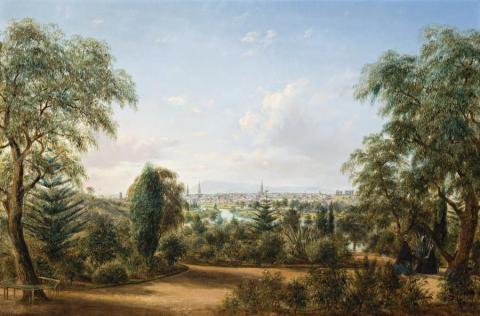VIEW OF MELBOURNE FROM THE BOTANICAL GARDENS, 1865
HENRY GRITTEN
oil on canvas
58.5 x 89.0 cm
signed and dated lower left: H. Gritten. 1865
Private collection, Western Australia
Christie's, Melbourne, 27 April 1998, lot 52
Private collection, Adelaide
Views of Melbourne from the Botanic Gardens were exhibited as follows:
Fine Art Exhibition, Public Library, December 1864, as 'Melbourne from the Botanical Gardens'; and The First Exhibition of the Victorian Academy of Art [sic.], Melbourne Public Library, November 1870, cat.85, as 'Melbourne from the Botanic Gardens'
View of Melbourne looking across the Yarra from the Botanical Gardens with Mount Macedon in the Distance, 1865, oil on canvas, 51.5 x 80 cm, Sotheby's, Melbourne, 27 November 1995, lot 23
Melbourne from the Botanic Gardens, 1865, oil on canvas, 51.0 x 78.0 cm, Sotheby's, Melbourne, 5 May 2003, lot 172
Melbourne from the Botanic Gardens, 1865, oil on canvas on plywood, 30.5 x 46.6 cm, Joseph Brown Collection, National Gallery of Victoria, Melbourne
View of Melbourne, Victoria, from the Botanic Gardens, 1866, oil on cardboard, 22.7 x 37.5 cm, National Gallery of Victoria, Melbourne
Melbourne from the Botanical Gardens, c.1867, oil on canvas, 84.0 x 137.0 cm, La Trobe Collection, State Library of Victoria, Melbourne
Melbourne from the Botanical Gardens in 1867, oil on academy board, 25.7 x 35.6 cm, La Trobe Collection, State Library of Victoria, Melbourne
Botanical Gardens, 1863, colour lithograph, drawn and printed by F. Cogne in Troedel, C., The Melbourne Album, Melbourne, 1863, pl.1 (based on a painting by Henry Gritten)
The most popular subject in Henry Gritten's entire oeuvre was undoubtedly the Melbourne Botanic Gardens. He painted six known versions, including this work, and it appeared as a colour lithograph in Charles Troedel's The Melbourne Album. Painting one or more similar versions of the same subject was common practice in nineteenth-century art. Eugene von Guerard, Nicholas Chevalier, Thomas Clark and Louis Buvelot all made good use of it. The rule seemed to be, the more popular the subject, the more often it was repainted. The Melbourne Botanic Gardens were enormously popular during the latter part of the nineteenth century. The well dressed promenaded, military bands played, and 'concerts for benevolent objects' and flower shows drew large crowds. The labours, both scientific and aesthetic, of their director, Ferdinand von Mueller were warmly praised, the gardens providing 'the most delightful resort near Melbourne' and giving'most charming views of the City and its environs...'1 All is captured by Gritten, the figure group in our painting placed to one side to enjoy the gentle shade of a large tree. The artist's focus is very much on the wonderful range of botanic specimens already well established, like the distant view of the growing city in the background. The general view is to the north with the Macedon Ranges providing a silhouetted backdrop to the city. Many of the finest buildings can be identified - the spires of the Collins street churches of St Enoch's and Scots Church, the Treasury Building newly built of Bacchus Marsh stone, Messrs Knight and Kerr's incomplete Parliament House, and St Patrick's Cathedral under construction, grand evidence of burgeoning Melbourne. The Gardens and its City are linked by the gently flowing waters of the River Yarra.
Although each of Gritten's views appears to have been taken from the same vantage point, each is engagingly different in presentation and detail. The panoramic spread of the city may be much the same in each but he varied considerably the vegetation, figures, actions and their groupings. He thought so highly of his rendition of the subject that he entered an earlier version in the Victorian Government's 1864 competition of £200 for the best painting by a colonial artist, the winning work to be acquired for the new National Gallery of Victoria. Nicholas Chevalier won, but Gritten received very favourable press. One correspondent wrote: 'This work will be a most attractive feature in the exhibition, in as much, besides possessing the merit of being carefully circumstantial in local details, its contrasts of colour are highly pleasing, and the coolness and repose which characterize the effect are very refreshing to the eye.'2 A follow up report admired its care in the attention paid to 'the individualities of the foliage', the scribe prophetically observing - 'Being a local subject, familiar to everybody, its attractiveness is sure to be maintained.'3
1. Illustrated Melbourne Post, 25 April 1862, p.31
2. Ibid, 22 December 1864, p.3
3. Ibid, 25 January 1865, p.5
DAVID THOMAS
